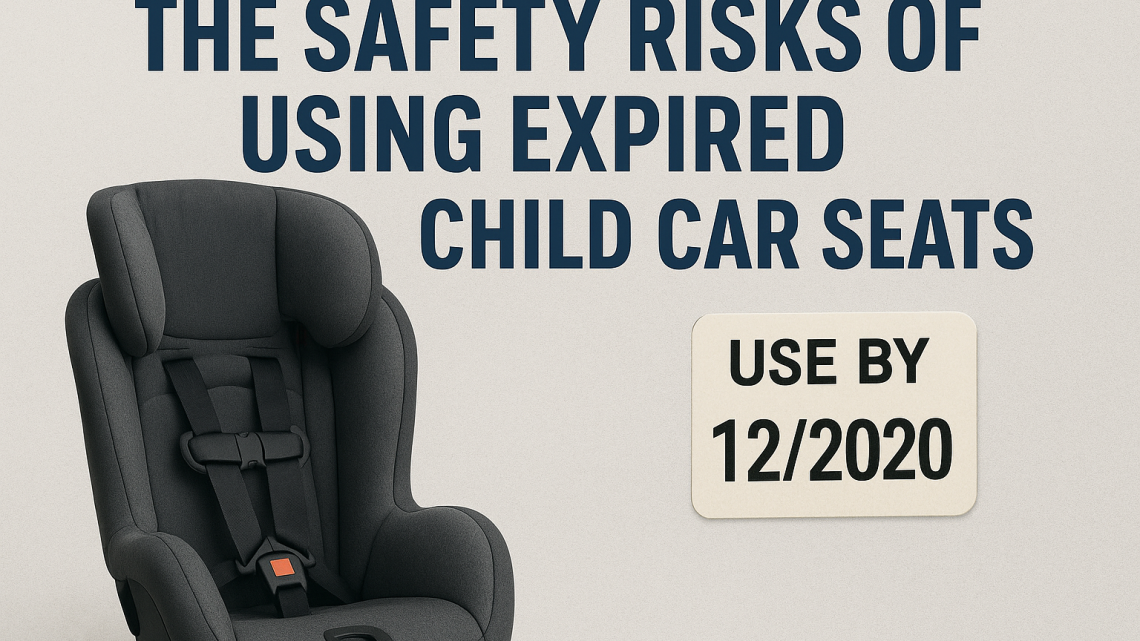The Safety Risks Of Using Expired Child Car Seats is a topic that matters to every parent and caregiver in the USA.
If you own a baby car seat, an infant seat, or a booster seat, you may wonder how long are car seats safe to use, where to find the model number, and what the car seat expiration dates really mean.
Many parents trust guidance from the American Academy of Pediatrics and federal agencies like the National Highway Traffic Safety Administration when deciding whether to keep a car seat, whether to use a car seat base, or when to search for replacement parts.
Read on, because knowing how expiration dates affect performance can keep your child safer after a crash, and that peace of mind is worth the time.
Dangers Of Outdated Child Restraint Systems
Car seats and child restraints are not simple boxes with straps. They are carefully engineered systems that combine webbing, foam, plastic, buckles, and sometimes metal parts.
Over time those materials change. Plastic can become brittle. Foam can break down. Labels fade, and instruction manuals are misplaced, so people install seats wrong, or use car seats without base hardware that fits an older vehicle.
The result is a child car seat that will not protect a child the way it did the day it was new.
Manufacturers set car seat expiration dates for good reasons.
Many car seat manufacturers recommend a lifespan between six and ten years, because tests show parts that look okay can perform poorly in a crash after long exposure to heat, sunlight, or repeated use.
Consumer Reports has covered how older seats may fail to protect children the same way newer models do, and the Consumer Reports guidance is a helpful place to compare real-world crash-test results.
The biggest safety concerns with expired car seats include weakened connectors, stretched straps, compromised foam, and buckles that jam or fail under stress.
Those are not small problems when a crash happens.
Decreased Crash Test Performance Risks
Crash tests are not just for show, they measure how a seat manages forces that occur during a real collision.
Older models may have been tested under safety standards that are now out of date, or they may have been modified by owners, so their crash-test performance becomes unpredictable.
Newer seats include improved safety features, such as better side-impact protection, energy-absorbing foam, and improved harness geometry, which can reduce the risk of head and neck injuries.
The National Highway Traffic Safety Administration and other groups run crash tests and publish findings, and those results show progress in safety design over time.
You can see current crash-test and consumer guidance through the NHTSA site and review updates from the Consumer Reports car-seat resources. Older seats may lack new safety labels, instruction manuals, or compatibility with vehicle latch systems, and that directly affects how well the seat controls the forces of a crash.
If you are asking, can expired car seats protect a child, the honest answer is, sometimes, but not reliably.
The odds of protection drop as the seat ages, especially beyond the manufacturer suggested expiration date.
How To Inspect Your Car Seat
Want to know if a car seat is safe?
Start with a physical inspection and the instruction manual, when you can find one.
Check the label for a model number and the manufacture date, both are usually stamped onto the plastic shell or on a sticker.
Look for an expiration date or an expiration period written in years after the manufacture date.
If you do not find one, contact the car seat manufacturer and provide the model number and the serial number so they can tell you the recommended lifespan and whether replacement parts are available.
Inspect these components carefully:
- webbing and straps for frays, fading, or brittleness
- buckles that click firmly and release easily
- plastic shell for cracks, gouges, or distortion
- car seat base for visible damage and for secure latch system engagement
- safety labels that list the weight limit, model number, and manufacture date
If you see missing parts, repaired sections, or any signs the seat was in a crash, retire the seat.
Even if it looks fine, a seat that was in a crash may have hidden damage that reduces its effectiveness.
For help with hands-on inspection and installation, certified child passenger safety technicians are good resources, and many communities list technicians through the NHTSA and organizations like Safe Kids.
Material Degradation And Safety Failures
Materials in car seats age.
Plastic exposed to sun and heat changes chemically.
Foam used for energy absorption can compress and become less effective.
Webbing stretches and loses tensile strength after repeated use, and buckles can collect dirt, making them fail under load.
Over time food, spills, and exposure to elements accelerate wear.
That wear affects performance, and you do not need a full break to see a difference, sometimes small cracks in a shell or a brittle connector mean the seat absorbs less energy in a crash.
Studies looking at long-term exposure of materials show that ultraviolet light and high temperatures alter polymers in predictable ways.
Research from leading institutions, including groups at places like Karolinska Institutet, raises awareness about material aging in safety equipment.
While those studies may not always focus strictly on car seats, they do provide context for why manufacturers set expiration dates, and why you should treat those dates seriously.
If you are wondering how does an expired car seat fail, think of it like an old bicycle helmet, the shell might look whole, but the foam inside can crumble and no longer protect the head properly.
Same idea for car seats, but the forces are different and the stakes are higher.
Protect Your Child With Updated Restraints
Keeping children in up-to-date child restraints is one of the best ways to reduce risk in a crash.
Follow safety guidelines from the American Academy of Pediatrics, which recommends that children ride in rear-facing car seats as long as possible, then in forward-facing seats with harnesses, and then in booster seats until the vehicle seat belt fits properly.
State child passenger safety laws vary, but all states have rules about age, weight, or height for different restraint types.
You can look up your state laws at your department of motor vehicles or through national resources like the NHTSA.
Replacement makes sense when a car seat has reached its expiration, when a manufacturer has issued a recall and no remedy is offered, or if the seat shows signs of crash-related damage.
If you are considering a used seat, make sure you have the original instruction manual, verify the model number and manufacture date, and confirm there is no recall history.
If any part is missing, or if the seat has unknown history, skip it. A car seat trade or hand-me-down can save money, but it also carries risk if the history is unclear.
Regulatory Updates Impact Car Seat Safety
Safety standards evolve. Regulators update testing procedures, require new labels, and mandate improved safety features.
For example, the National Highway Traffic Safety Administration updates federal standards and testing protocols that influence how manufacturers design seats, and those updates can mean newer models outperform older models in crash scenarios.
You can find current federal guidelines and recalls at the NHTSA website and check a specific seat by using its model number and manufacture year.
Recalls matter. If a car seat manufacturer issues a recall, the remedy may be a replacement part, repair, or a request to stop using the seat.
Always register your car seats with the manufacturer so you receive recall notices.
The presence of an instruction manual and safety labels is also part of compliance.
If labels have faded or the manual is missing, request a replacement manual from the car seat manufacturer.
Many car seat manufacturers provide product registration and manuals online, and replacement parts can sometimes be ordered directly from the manufacturer.
If replacement parts are no longer available because the model is old, that is another reason to replace the seat.
When To Replace An Expired Car Seat
When should expired car seats be replaced?
Replace a seat immediately if it has been in a moderate to severe car accident, regardless of whether visible damage is present.
Replace a seat when the manufacturer recommended expiration date has passed.
Replace a seat if parts are missing or replacement parts are not available.
And replace a seat if you cannot find the model number, manufacture date, or instruction manual, because you cannot confirm the safety labels or whether the seat was recalled.
Ask these questions to decide if you should replace a seat:
- Is the seat past its expiration date listed by the manufacturer?
- Has the seat been in a crash, even a minor one?
- Are parts such as harnesses or buckles damaged or missing?
- Do you have the original instruction manual and installation guidance?
- Has the manufacturer provided a remedy for a recall?
When in doubt, replace.
Newer car seats also often include better safety features and compatibility with the vehicle latch system, and that can make installation easier and more secure.
Many communities host car seat checks where child passenger safety technicians will inspect seat condition and installation free of charge.
Search for local events through NHTSA resources or Safe Kids Worldwide.
Why Expiration Dates Matter For Car Seats
Expiration dates are not arbitrary.
They reflect a combination of expected material lifespan, changes in safety standards, and product support availability.
They tell you when the manufacturer no longer guarantees performance, replacement parts, or repair guidance.
Car seat expiration dates protect you and your child from the hidden effects of aging components, from safety features that no longer meet newer standards, and from the risk that a cracked shell, brittle buckle, or degraded foam will not perform as intended in a crash.
Here are direct answers to common questions parents ask:
- Can expired car seats protect a child? Sometimes they will, but not reliably. Expired seats have passed the time the manufacturer intended them to perform, and material degradation or outdated testing standards make protection uncertain.
- How do expiration dates affect car seat performance? Expiration dates reflect when a seat may no longer meet the original performance levels due to material aging and changing safety standards, so performance can drop off after that date.
- How does an expired car seat fail? It can fail when the shell cracks, when energy-absorbing foam compresses or crumbles, when buckles jam, or when webbing loses tensile strength. Those failures mean the seat may not restrain the child correctly in a crash.
- What are safety concerns with expired car seats? Missing or degraded parts, inability to get replacement parts, faded safety labels, lack of manual, and unknown recall status are all serious concerns.
- What risks come from older car seats? Higher injury risk in crashes, decreased protection in side impacts, and incorrect fit with modern vehicles and latch systems.
- What steps ensure proper car seat installation? Read the instruction manual, check the model number and manufacture date on the label, use the vehicle seat belt or the latch system correctly, and consider having a certified child passenger safety technician verify the installation. See hands-on help via NHTSA and local safety check events.
- When should expired car seats be replaced? Replace immediately after a crash, after the expiration date, when parts are missing or damaged, or when the seat has an unknown history or is subject to an unresolved recall.
Other practical tips, because they matter: always register your car seat with the manufacturer so you get recall notices, keep the instruction manual in the glove box, and write the manufacture date on a durable place on the shell if the label fades.
If you need to dispose of an expired or recalled car seat, find a local recycling facility or a safe disposal program.
The EPA has recycling resources, and Safe Kids Worldwide offers guidance on disposal and recycling options.
Finally, remember that wearing a proper seat belt matters for older children who have outgrown car seats and booster seats.
Seat belts are a last line of protection, and laws across states vary on when kids can ride without a booster.
Check your state child passenger safety laws and follow the American Academy of Pediatrics guidance for seat belt fit and age-appropriate protection.
If you are unsure about any car seat concern, find a certified child passenger safety technician to help.
Their hands-on advice can make the difference between an installation that is just okay, and one that reliably protects your children in a crash.




No Comment